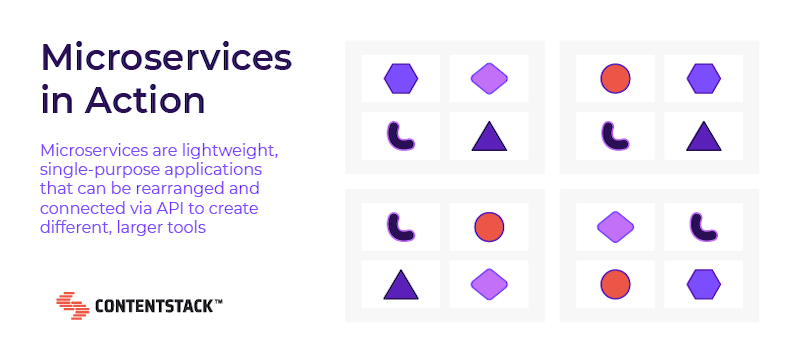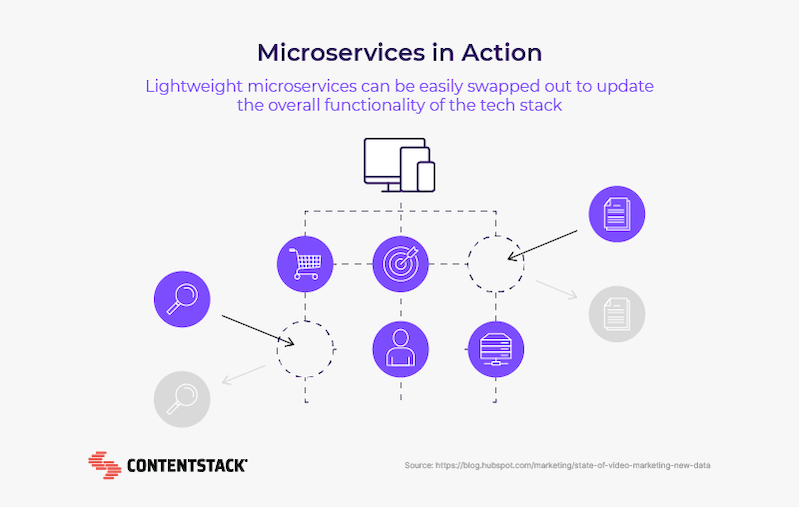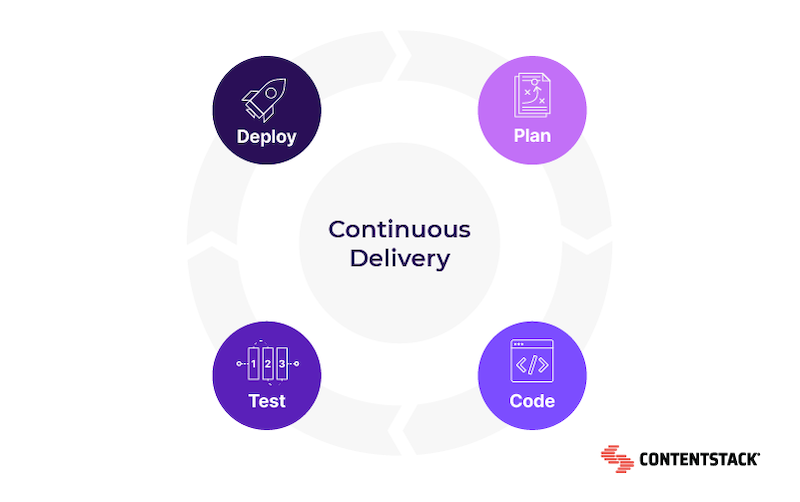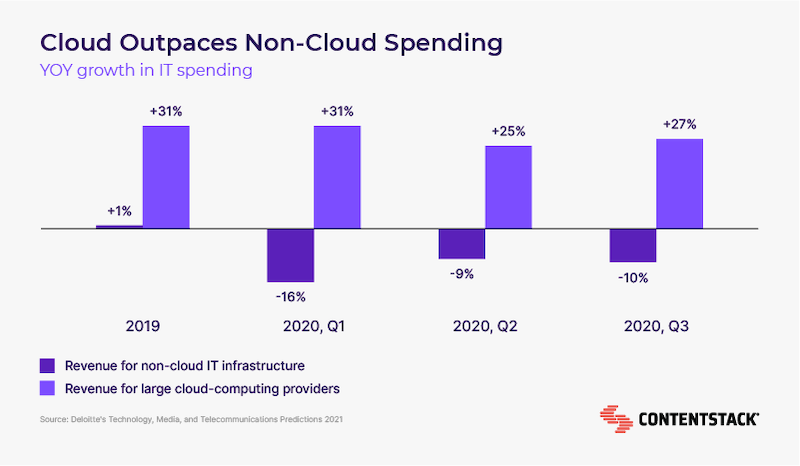Microservices in cloud: Your gateway to efficient business tech

Discover the benefits of microservices in cloud computing for business efficiency. Learn about relevant cloud technologies and how you can build, test and deploy products with speed and accuracy. Move ahead of the competition by leveraging cloud features, starting with a composable DXP. Request a demo to see how it works.
Highlights
You'll learn:
- To understand everything about microservices and their role in cloud computing.
- Discover relevant concepts and technologies, like bounded context, containers, service mesh and more.
- The synergy of microservices in the cloud and how it enhances application development.
- Explore the main components of microservices in the cloud, such as independent deployment, fault tolerance, and CI/CD strategies.
- Understand the benefits of implementing microservices in cloud environments, like speed, elasticity and resource efficiency.
- See real-world success stories of microservices in the cloud via composable DXP.
Microservices and cloud computing are like a match made in heaven. Take the first step to jumpstart your digital strategy. Request a demo to see how it works!
Keep reading to learn more!
Gartner predicts that 95% of new digital projects will be built on cloud-native platforms by 2025. Microservices and cloud computing provide businesses with an effective way to develop and deploy scalable and resilient applications. They can enjoy the benefits of cloud computing in business technology by opting for a composable DXP.
Understanding microservices in the Cloud
A microservice is an architecture that breaks down applications into smaller services that are independent and use their resources.
The services are loosely coupled, enabling you to scale, deploy and develop them on their own. This architectural style makes it a good fit for building software for the Cloud.
The benefits of microservices address many of the problems you can associate with monolithic applications.
Cloud-native microservices help you deploy faster and enable you to scale. It enhances your agility and resilience, speeding up your ability to develop new digital experiences. Organizations that transition to microservices can enjoy these benefits.

Key concepts and technologies
Bounded context and independent deployable services: These concepts ensure that each microservice has a separate logic and domain. That way, they remain independent, and you reduce conflict. With both in place, teams can focus on specific business processes. They can also modify and update services without impacting the entire system.
Containers and virtual machines (VM): both offer isolated environments to execute microservices. Containers are lightweight and efficient in managing virtualization. Virtual machines provide full virtualization. They sum up the entirety of an operating system within one instance. So you can work with different operating systems and manage your resources better. You can use both approaches, depending on the nature of your project.
Cloud integration services: This integration manages how microservices communicate and share data in the Cloud. It also offers key features to develop, deploy and manage cloud-native systems.
Service mesh: A service mesh is a dedicated software layer that is responsible for service-to-service communication in applications. It ensures swift delivery of requests through complex topology of microservices on cloud-native applications and provides features such as routing and traffic configuration, monitoring, logging, and service discovery.
API management: API management refers to how you develop, design, test, monitor, and manage APIs within an environment. It ensures you can access and use secure API. It is also central to data security and governance.
Elastic load balancing: A cloud service distributes network traffic among various cloud targets, such as containers and EC2 instances. It manages traffic and sends it to the most health target. It enhances fault tolerance and ensures you are always available.
Start your free trial with Contentstack today. Transform your brand's digital presence with Contentstack's open MACH architecture and industry-leading technology. Witness a significant reduction in publishing and development time, and elevate your content management. Start your free trial now.
Synergistic approach to application development
Cloud computing offers computer system resources on-demand that enable developers to deploy and scale microservices as they suit business objectives.
Integrating microservices and cloud computing offers many benefits. For instance, with auto-scaling, you can manage demand when it fluctuates. You also enjoy wider reach as the cloud provides a global platform.
There is also the angle of cost. The cloud allows you to pay only for what you use. So, instead of paying for a whole application as you would in a monolith, you only pay for a microservice when they are in use. This is another benefit of going from monolithic to microservices.
Microservices in the cloud also ease scaling. Imagine your app gets more users and needs to handle more work. Having your microservices running on the cloud is like having a team that can clone its members to handle extra work on the go. That means you can go from handling a few hundred users to millions of users without crashing.
Core components of microservices architecture in the cloud
Independent deployment: Cloud-native microservices being loosely coupled allow you to deploy individual components faster. For instance, if you have an e-commerce app and you need to update payment processing, you can do so without touching the other parts of the app.
Fault tolerance and resilience: Microservices are designed to withstand component failures and continue operation without failing. It does so by handling and correcting errors. Circuit breakers are part of the system and prevent a failing service from affecting others.
Continuous integration/continuous deployment (CI/CD): It enables you to automate software delivery. You can build, test and deliver digital products in the CI/CD pipeline. So, developers spend more time on innovation rather than on repetitive tasks.
Orchestration and provisioning in the cloud: This is dynamic and automatic, enabling the system to allocate resources like memory or computing power. It optimizes resources, ensuring you can scale and manage microservices.

Advantages of microservices in cloud computing
Elasticity: It is the ability to adjust cloud-based resources to varying demands to manage workload, enabling businesses to be more efficient with their resources.
Cost-efficiency: With microservices in cloud computing, you only pay for what you use. That prevents businesses from paying for resources they do not use.
Developer independence: Developers can use various tech stacks to develop the application. Also, different development teams can work on different application components without affecting each other's production.
Scalability: If a service requires extra resources, the cloud provides it. That means you can adjust to new demands without affecting other microservices. You can scale up or down based on business demands.
Fault isolation: Cloud platforms have built-in redundancy and disaster recovery. So, when one microservice gets faulty, it does not disrupt other microservices. Microservices in cloud computing allow you to continue operation while you fix one part of the system.
Agile software development: With microservices in cloud computing, it is easier and faster to update, fix bugs and ass new features. That leads to quicker time to market.
Experience future-ready DXP with Contentstack. Contentstack, identified by Forrester's composable DXP award, is an industry leader for enterprises wanting to future-proof their digital strategy. Our high scores in vision and innovation speak for themselves. Request a demo to explore our best-in-class features.
Implementing microservices in cloud environments
1. Understand the cloud environment: It is crucial to understand the features of the cloud platform. Consider its security mechanisms, deployment models, scalability options, and critical infrastructure, like its network architecture, data storage, and data centers.
2. Design services for business requirements: Design microservices specific to the needs of your business. Identify the functions you must separate to ensure that microservices have a defined purpose. That will also enable you to deploy and scale them with ease.
3. Deploy with containers: Containers are lightweight and efficient. They provide an isolated runtime environment. You can also move microservices across cloud environments. Using containers like Dockers also enables you to scale in real time.
4. Go serverless: Tools like AWS Lambda enable you to scale microservices in a cloud-native environment. It is dynamic and does not require you to manage any underlying system. That way, you focus on creating value while the cloud service scales and manages the resources.
5. Implement CI/CD pipelines: CI/CD pipelines enable continuous delivery. These tools automate the process, lowering the time it takes to test, build, test and deploy. It helps you save time while you maintain quality and increase delivery speed. It also enables development teams to iterate and push updates more frequently.

6. Use cloud orchestration tools: Tools like AWS ECS or Kubernetes manage and automate monitoring. They also enable you to scale and deploy in the cloud. These tools manage containerized applications, enabling fault tolerance, high availability, and better resource usage.
Importance of cloud services
Cloud services provide infrastructure on demand. With AWS, you can provision resources and scale when you need to. Hence, you do not need to manage any on-premise infrastructure. Cloud providers handle all of that, which frees up time for you to innovate. AWS also offers messaging queues and databases.
Using containers provides isolated environments for you to deploy microservices. They are portable and flexible, enabling you to run services across computing environments. With serverless, you can run code on-demand without any supporting infrastructure.
Cloud services like AWS, containers, and serverless computing enable you to build in a cloud-native environment. They help you scale and deploy at pace. They also allow you to manage resources as you only pay for what you use.

Case studies
Richie Bros
The Richie Bros challenge was a common one. As demands increased, so did the development work to maintain the CMS. They needed a solution that would optimize the work of the engineering and marketing teams.
Contentstack's composable DXP offered them a flexible and scalable solution, enabling them to manage demand as it came in. Their content creators also had more freedom, and developers spent less time on tickets.
According to Michael Harker, Director of Product, "It's now extremely easy for the marketing team to go and change content, and that immediately flows to the website without needing any technical assistance."
Read more about how Ritchie Bros freed up developers with a composable DXP.
Dawn Foods
Before 2019, Dawn Foods took others manually, via telephone and in person. They needed an e-commerce option to simplify things for their customers. Contentstack's composable DXP provided that.
Switching to Contentstack enabled them to enjoy a cloud-native, API-first, headless solution that supports microservices. The solution helped them to understand their customers better, leading to 40 updates in the first month. It also increased their speed and efficiency.
Hear from Bob Howland, Chief Digital Officer. "Every week, we're seeing registered customers buying the same products, plus one or two new ones. And once a customer places two or three orders online — then they are sold on the online channel, and then only place orders online."
Read more about Dawn Food's success story with a composable DXP.
FAQ section
What is a cloud-native approach?
It is an approach that focuses on building products and systems that you can manage, deploy and operate in the cloud. Cloud-native applications are flexible, resilient and scalable.
How does fault tolerance work in microservices?
Fault tolerance isolates microservices, so if one of them fails, it does not affect the whole system. It also works with load balancers to distribute traffic, ensuring you can run various service instances without overwhelming the system.
What are the benefits of using microservices for cloud Applications?
It saves costs because you only pay per use. It also makes it easy for you to scale. It increases agility and speed, ensuring you can deliver digital products for better user experiences.
How do microservices communicate in a cloud environment?
They communicate through APIs, event streams, service mesh, and message queues. RESTful APIs send and receive messages via HTTP, while event streams notify services when there is an update or new event.
Can microservices and monolithic architectures co-exist?
Yes. There are several approaches you can use, such as the Strangler Fig pattern, the hybrid approach, shared resources, side-by-side operations, and inter-service communication.
Learn more
Working with microservices in the cloud enhances modern application development. It helps you save time, increases your speed, and you can save on resources. You can also deploy and deliver on-demand, leading to faster updates and quicker time to market.
A composable DXP allows you to enjoy all the benefits because it is cloud-native, headless, and API-driven. Look no further if you need a place to start. Request our free demo to get started.
About Contentstack
The Contentstack team comprises highly skilled professionals specializing in product marketing, customer acquisition and retention, and digital marketing strategy. With extensive experience holding senior positions at renowned technology companies across Fortune 500, mid-size, and start-up sectors, our team offers impactful solutions based on diverse backgrounds and extensive industry knowledge.
Contentstack is on a mission to deliver the world’s best digital experiences through a fusion of cutting-edge content management, customer data, personalization, and AI technology. Iconic brands, such as AirFrance KLM, ASICS, Burberry, Mattel, Mitsubishi, and Walmart, depend on the platform to rise above the noise in today's crowded digital markets and gain their competitive edge.
In January 2025, Contentstack proudly secured its first-ever position as a Visionary in the 2025 Gartner® Magic Quadrant™ for Digital Experience Platforms (DXP). Further solidifying its prominent standing, Contentstack was recognized as a Leader in the Forrester Research, Inc. March 2025 report, “The Forrester Wave™: Content Management Systems (CMS), Q1 2025.” Contentstack was the only pure headless provider named as a Leader in the report, which evaluated 13 top CMS providers on 19 criteria for current offering and strategy.
Follow Contentstack on LinkedIn.






.svg?format=pjpg&auto=webp)
.svg?format=pjpg&auto=webp)
.png?format=pjpg&auto=webp)






.png?format=pjpg&auto=webp)


